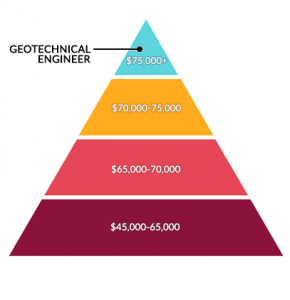Our Geotheta Ideas
Our Geotheta Ideas
Blog Article
How Geotheta can Save You Time, Stress, and Money.
Table of ContentsGeotheta for Beginners6 Simple Techniques For GeothetaMore About GeothetaGeotheta Things To Know Before You BuyUnknown Facts About Geotheta

They conduct site examinations, gather examples, perform lab tests, and assess information to examine the suitability of the ground for construction projects - Consulting Engineers. Based on their findings, geotechnical engineers provide recommendations for foundation design, incline security, keeping frameworks, and reduction of geotechnical threats. They team up with various other specialists, such as architects, structural designers, and construction teams, to make certain that geotechnical factors to consider are incorporated into the general job design and execution
By analyzing the habits and properties of soil and rock, they can identify prospective geotechnical threats such as landslides, dirt negotiation, or incline instability. Their expertise helps stop failures or accidents that can endanger lives and property. Right here are some in-depth duties and duties of a geotechnical engineer: Site Examination: Geotechnical designers conduct site investigations to collect data on subsurface conditions.
They translate the information to recognize the residential or commercial properties and habits of the dirt and rock, including their stamina, leaks in the structure, compaction qualities, and groundwater conditions. Geotechnical Analysis and Layout: Geotechnical engineers examine the data collected throughout website investigations to assess the stability and viability of the website for construction jobs. They execute geotechnical computations and modeling to examine factors such as bearing capacity, negotiation, incline stability, lateral planet pressures, and groundwater circulation.
The 45-Second Trick For Geotheta
Structure Design: Geotechnical designers play a critical function in creating structures that can safely sustain the intended structure. They examine the dirt conditions and load requirements to determine the proper foundation type, such as shallow foundations (e.g., grounds), deep foundations (e.g (https://www.dreamstime.com/ianhammond2191_info)., stacks), or specialized strategies like dirt renovation. They think about variables such as negotiation limits, birthing capacity, and soil-structure communication to create optimal structure layouts
They review construction plans, monitor site tasks, and conduct field evaluations to confirm that the design referrals are adhered to. If unpredicted geotechnical concerns arise, they examine the scenario and give recommendations for removal or modifications to the layout. Risk Evaluation and Mitigation: Geotechnical designers analyze geotechnical risks and threats connected with the job site, such as landslides, liquefaction, or dirt disintegration.

Collaboration and Communication: Geotechnical engineers work closely with other professionals associated with a job, such as architects, architectural engineers, and building teams. Effective communication and cooperation are vital to incorporate geotechnical considerations into the total task style and building and construction process. Geotechnical engineers offer technical competence, solution questions, and guarantee that geotechnical needs are met.
Not known Facts About Geotheta
Right here are some kinds of geotechnical designers: Foundation Designer: Foundation engineers focus on developing and assessing structures for frameworks. They assess the soil conditions, load needs, and website qualities to establish the most suitable structure type and style, such as shallow foundations, deep foundations, or specialized strategies like heap foundations.
They evaluate the elements affecting slope stability, such as dirt residential properties, groundwater conditions, and slope geometry, and establish strategies to prevent incline failings and minimize dangers. Earthquake Designer: linked here Earthquake engineers specialize in evaluating and making frameworks to withstand seismic pressures. They examine the seismic threat of a site, review dirt liquefaction possibility, and establish seismic style criteria to make sure the safety and durability of frameworks during earthquakes.
They perform field screening, collect samples, and assess the gathered data to define the dirt homes, geologic formations, and groundwater problems at a site. Geotechnical Instrumentation Designer: Geotechnical instrumentation engineers concentrate on monitoring and gauging the behavior of soil, rock, and structures. They set up and preserve instrumentation systems that keep an eye on aspects such as dirt settlement, groundwater degrees, slope activities, and architectural variations to examine efficiency and give early warnings of possible concerns.
The Ultimate Guide To Geotheta
They perform tests such as triaxial examinations, combination tests, straight shear examinations, and permeability tests to collect data for geotechnical analysis and layout. Geosynthetics Designer: Geosynthetics engineers specialize in the design and application of geosynthetic materials, such as geotextiles, geogrids, and geomembranes. They use these materials to enhance soil security, enhance inclines, give water drainage solutions, and control erosion.
They have a tendency to be investigative people, which indicates they're intellectual, reflective, and analytical. They are curious, systematic, reasonable, logical, and rational. Some of them are additionally social, implying they're kind, generous, cooperative, person, caring, helpful, understanding, skillful, and friendly - Tailings Engineer.
In the workplace atmosphere, geotechnical designers make use of specialized software application devices to perform calculations, develop layouts, and evaluate information. They prepare records, evaluation job specifications, interact with customers and team participants, and coordinate task tasks. The office setting offers a conducive setting for research study, evaluation, and collaboration with various other specialists entailed in the job.
The 5-Minute Rule for Geotheta
They frequently check out project websites to carry out website investigations, analyze geotechnical problems, and collect information for evaluation. These sees include traveling to various locations, often in remote or tough surfaces. Geotechnical engineers might execute dirt sampling, conduct examinations, and screen building activities to ensure that the geotechnical elements of the task are being executed correctly.
Geotechnical designers additionally work in specialized geotechnical laboratories. In these centers, they carry out experiments, carry out tests on dirt and rock samples, and examine the design buildings of the materials. Geotechnical laboratory engineers function extensively in these atmospheres, managing screening tools, running instruments, and recording data. They team up with other research laboratory staff to ensure accurate and dependable screening results.
Report this page